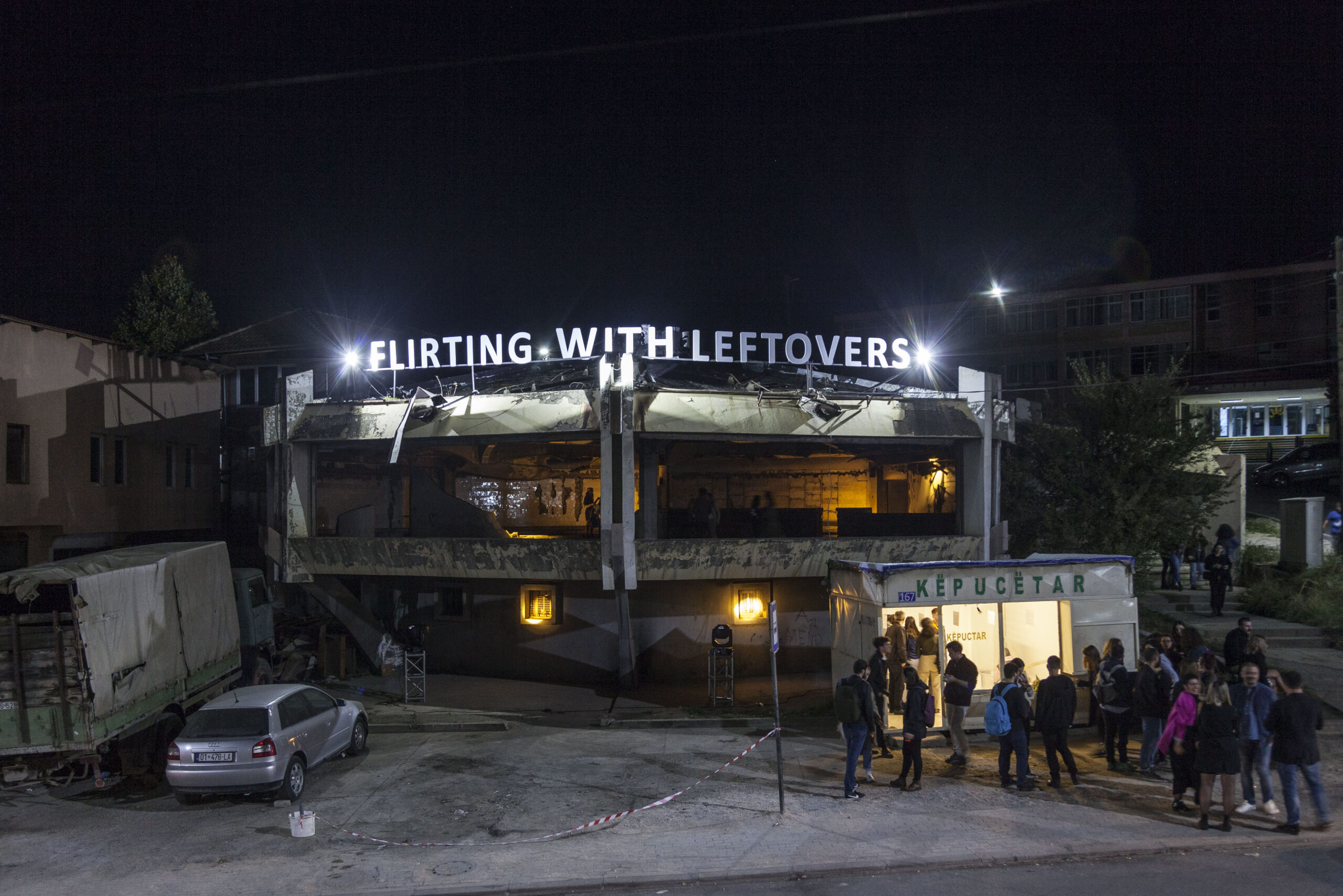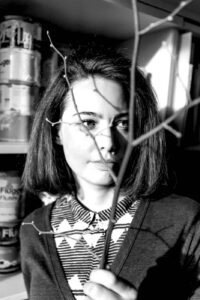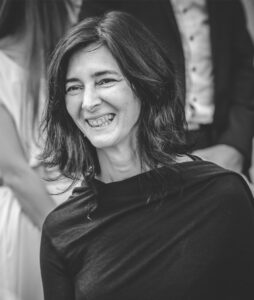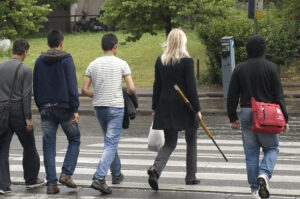Fitore Isufi Shukriu-Koja

— born in 1982, Kosovo — is a Prishtina-based multi-diciplinary artist. Koja’s work is conceptually based. The issues that stimulate her creation are inspirational stories and various interpretations, political maneuvers and cultural speculation, gender inequality and aleatory gestures, the limits of freedom, and forms of censorship. Koja’s work has been proved in different projects, exhibitions, and individual presentations, both locally and internationally. Recently she published a book “Flirting with leftovers.” She is a lecturer at UBT, Prishtina, and Art Director of Foundation Shtatëmbëdhjetë (17).
Seen from today’s perspective, I can say that the neighborhood I grew up in played an immense role in my aesthetic and emotional upbringing, specifically the famous Soliter (high-rise building), the iconic building of the city of Gjilan. For us, we considered theatre and cinema to be the courtyard. A city that had no gallery, but an improvised space for a gallery. These venues formed a triangle of cultural institutions, the representatives of such, discharging all their political and ideological attitudes and orientations, the art and culture involved in the theatre buffet, filled with plumes of smoke and thoughts. My role in this midst was one of a withdrawn adolescent observer.
It was the 90s, the time when the Kosovo autonomy was revoked. The repressive Serb regime closed cultural and educational institutions and, as a result, Albanians established parallel institutions, manifesting thus resistance towards this repression. The activities that took place during the 90s turned improvisation into a cult – my true education in arts and life. It was exactly the period when I had begun to follow cultural events in the country and, inevitably, embraced this as our collective school of resistance and survival.
Theatrical shows towards the end of the ’90s were politically charged, with scenography and costumes, which in the majority of cases displayed, in a simplified manner, the problems of our time. Nevertheless, it was sufficient enough to carve in me the dramatic images which translated into simplicity and furthermore with surprisingly reduced aesthetics. Cinema as well marked a decline in dynamics, which I more frequently experienced as white screen [ekran të bardhë], already another morbid reduction. Meanwhile, the gallery had taken a downturn for the worse and promoted a lot of folklore in its content, which led to it no longer being a cultural reference for me. The only thing that remained from this experience in the gallery was the overturning of my relationship with the white cube [kubi i bardhë].
Hence, being exposed continuously to fragile and unstainable political and socio-economic systems throughout my entire life, I cannot help but express my doubts in their authenticity then and now, but also in the years to come. As a result, we have inherited a system of art today which is lacking in many aspects, very little developed in other aspects, in order to be functional and useful for the artistic community. Having art as a form of expression and as work, it is inevitable that you will face the voids this system creates. A system of art that shapes you as a person, but diminishes you as an artist, because feeling without a proper and supporting structure, I simply find myself not producing art continuously. I more often find myself articulating and getting involved in initiatives and spaces where my engagement supersedes me and my art.
Therefore, inspiring stories and different interpretations, political maneuvers and cultural speculations, gender injustices, and random gestures, freedom boundaries, and forms of censorship, have been and continue to be part of my observation and my notes, which take form either in my creations or other professional involvements. But they can also remain as chronological notes, which perhaps someday may be taken up.
“Japonia” (“Japan”)12, 2005 or the flag of (un)virginity, as one of the first videos of mine, illustrates precisely this observation. It has to do with the celebration of the virginity of a woman following the first night of her marriage. Through the raising of the bed sheet with the blood stain in the middle – alluding thus metaphorically to the flag of Japan through its symbol – at the same time hides and reveals multiple layers of meanings, intertwined with social norms, the prevalence of patriarchalism, and misogyny in Kosovar society. It is an attempt of mine to translate and interpret this controversial issue into a minimalist image which reflects attempts of modern societies in abstracting this issue of importance for social emancipation.
I can say that the life I lead, my attitudes in relation to family and motherhood, my social and cultural engagement through art and other engagements, also manifest my political ideological flirtations –leftist, upon which I articulate myself and act upon. The global capitalist order, being neoliberalist and imperialist, does not represent human rights, least of all gender rights to which I belong, or initiatives I believe in and which keep me motivated and engaged in my social and professional life.
In art and in life, I am sure only about the doubts that the prevail socio-political, cultural and economic systems are instilled in me within the country and beyond. Therefore, my work and my engagements are simply a commentary and interpretation focused on different and debatable social issues. Currently, the collection of pieces of historical and cultural memories are serving me in building previously lacking references of identity but also cultural past, through art as a tool for self-historicization and aesthetic rearticulation. Furthermore, also as a confrontation with my past practice, which was built under the frailty of formative socio-political structures of my country.
An abandoned building of modernity, former restaurant “Marsi”345678, has become the reason for me to plunge deep and seek answers to a number of questions as to what we are today. Delving into the history of the building, in ensuring the necessary materials, have enabled me to tell this story through photos, interviews, and artifacts. In particular, it has enabled me to return to the childhood of former Yugoslavia, adolescence in a parallel system, and then war, as well as youth which is characterized by the continuous confrontation with insecurities created by a prolonged transition in the place you live. As a result, you understand how deterministic the past can be in decisions of life and professional journey, in artistic expressions, but undoubtedly also in artistic tastes.
1Image: Fitore Isufi Shukriu- Koja, Japan, Videostil image, 2006.2Image: Fitore Isufi Shukriu- Koja, Japan, Videostil image, 2006.
3Image: Fitore Isufi Shukriu- Koja, Foundation Shtatëmbëdhjetë (17), Metamorphosis II, Site Specific Artistic Intervention, FLIRTING WITH LEFTOVERS, Photo Majlinda Hoxha, 2019.
4Image: Fitore Isufi Shukriu- Koja, Foundation Shtatëmbëdhjetë (17), Metamorphosis II, Site Specific Artistic Intervention, FLIRTING WITH LEFTOVERS, Photo Majlinda Hoxha, 2019.
5Image: Fitore Isufi Shukriu- Koja, Foundation Shtatëmbëdhjetë (17), Metamorphosis II, Site Specific Artistic Intervention, FLIRTING WITH LEFTOVERS, Photo Majlinda Hoxha, 2019.
6Image: Fitore Isufi Shukriu- Koja, Foundation Shtatëmbëdhjetë (17), Metamorphosis II, Site Specific Artistic Intervention, FLIRTING WITH LEFTOVERS, Photo Majlinda Hoxha, 2019.
7Image: Fitore Isufi Shukriu- Koja, Foundation Shtatëmbëdhjetë (17), Metamorphosis II, Site Specific Artistic Intervention, FLIRTING WITH LEFTOVERS, Photo Majlinda Hoxha, 2019.
8Image: Fitore Isufi Shukriu- Koja, Foundation Shtatëmbëdhjetë (17), Metamorphosis II, Site Specific Artistic Intervention, FLIRTING WITH LEFTOVERS, Photo Majlinda Hoxha, 2019.
— lindur më 1982, Kosovë — është artiste multi-disiplanare me bazë në Prishtinë. Puna e Kojës është konceptuale. Çështjet të cilat e stimulojnë krijimin e saj janë rrëfime inspiruese dhe interpretime të ndryshme, manovra politike dhe spekulime kulturore, pabarazia gjinore dhe gjeste rastësore, kufijtë e lirisë, dhe format e cenzurës. Puna e Kojës është dëshmuar në projekte të ndryshme, ekspozita dhe prezantime individuale, si vendore ashtu edhe ndërkombëtare. Së fundi, ajo publikoi një libër “Flirting with leftovers”. Ajo është ligjëruese në UBT, Prishtinë, dhe Drejtoreshë Artistike e Fondacionit Shtatëmbëdhjetë (17).
Shikuar nga sot, mund të them që lagjja ku jam rritur, ka luajtur rol të madh në sendërtimin tim estetik e ndijësor, më saktësisht Soliteri i famshëm, ndërtesa ikonë e qytetit të Gjilanit. Ne banorët e tij, oborr e konsideronim teatrin dhe kinemanë e qytetit. Një qytet që nuk kishte galeri, por një hapësirë të improvizuar për galeri. Kështu së bashku e përbënin një trekëndësh të institucioneve kulturore, përfaqësuesit e të cilave shkarkonin të gjitha qëndrimet dhe orientimet tyre politike e ideologjike, artin dhe kulturën e angazhuar në bufenë e teatrit, të mbushur me shëllunga tymi e mendimesh. Roli im në këtë mes, ishte i një adoleshenteje të tërhequr observuese.
Ishin vitet ‘90, kur edhe u revokua autonomia e Kosovës. Regjimi represiv serb i mbylli institucionet kulturore dhe arsimore, si pasojë shqiptarët krijuan institucione paralele, duke manifestuar kështu rezistencë ndaj këtoj represionit. Aktivitetet që zhvilloheshin në vitet ‘90, e ngritën në kult improvizimin – edukimin tim të vërtetë në art e në jetë. Ishte pikërisht periudha ku unë kisha filluar të ndjekja ngarjet kulturore në vendn dhe përvetësoja pashmangshëm këtë shkollën tonë kolektive të rezistencës dhe mbijetesës.
Shfaqjet teatrore në vitet e fundit të të ‘90-ave ishin të rënduara politikisht, me skenografi dhe kostumografi që në të shumtën e rasteve paraqitnin në formë të thjeshtëzuar problemet e kohës. Megjithatë, mjaftueshëm për të gdhendur tek unë imazhet dramatike të përkthyera në thjeshtësi dhe me një estetikë habitshëm të reduktuar. Kinemaja po ashtu kishte një rënie në dinamikë, të cilën më shpesh e kam përjetuar si white screen [ekran të bardhë], tashmë një tjetër reduktim morbid. Ndërkaq, galeria kishte marrë tatëpjetën dhe promovonte shumë folklor në përmbajtjen e saj, gjë që kishte filluar të mos jetë më referencë kulturore për mua. E vetmja gjë që më mbeti nga kjo përvojë me galerinë, ishte përmbysja e marrëdhënies time me white cube [kubi i bardhë].
Andaj, e ekspozuar në vazhdimsi ndaj sistemeve të brishta e të paqëndrueshme politike e socio-ekonomike, përgjatë gjithë jetës sime, nuk kam si të mos shfaqi dyshime në vërtetësinë e tyre dikur dhe sot, por edhe në vitet që do të vijojnë. Si pasojë sot e kemi të trashëguar një sistem arti të mangët në shumë aspekte, në shumë aspekte pak e zhvilluar, për të qenë funksional dhe i dobishëm për komunitetin artistik. Duke e pasur punë dhe formë të shprehjes artin, është e pashmangshme përballja me boshllëqet që ky sistem t’i krijon. Një sistem arti që të rritë si njeri, por të zvogëlon si artiste, sepse duke u ndjerë pa një strukturë të mirëfilltë e mbështetëse, thjeshtë e gjejë veten duke mos prodhuar art në vazhdimësi. Më shpesh e gjejë veten duke u artikuluar dhe përfshirë në iniciativa dhe hapësira ku angazhimi im më tejkalon mua dhe artin tim.
Andaj, tregimet inspiruese dhe interpretimet e ndryshme, manovrimet politike dhe spekulimet kulturore, padrejtësitë gjinore dhe gjestet rastësore, kufijtë e lirisë dhe format e censurës, kanë qenë dhe vazhdojnë të jenë pjesë e observimit tim dhe shënimeve të mia, të cilat marrin jetë qoftë në krijimet e mia, qoftë në angazhimet tjera profesionale. Por, mund edhe të mbesin si shënime kronologjike, që mbase mund të konsiderohen një ditë.
“Japonia”12, 2005 apo flamuri i (ç)virgjërisë, si njëra nga videot e para të mia, e ilustron pikërisht këtë observim timin. Bëhet fjalë për festimin e virgjërisë së një gruaje pas natës së parë martesore. Përmes ngritjes së qarshafit me njollën e gjakut në mes – duke aluduar në mënyre metaforike në flamurin e Japonisë përmes ikonografisë së tij – njëkohësisht fsheh dhe shpalos shtresime të shumta kuptimore, të ndërlidhura me normat shoqërore, mbizotrimin e patriarkatit e mizogjininë në shoqërinë kosovare. Një tentativë e imja për të përkthyer e interpretuar këtë temë kontraverse në një imazh minimalist, i cili i reflekton tentativat e shoqërive të sotme për ta abstrahuar këtë çështje me rëndësi për emancipimin shoqëror.
Mund të them që jeta që unë bëj, qëndrimet e mia në raport me familjen dhe mëmësinë, angazhimin social e kulturor përmes artit dhe angazhimeve tjera, po ashtu manifestojnë flirtimet e mia ideologjike politike – të majta, mbi të cilat artikulohem dhe veproj. Rendi botëror kapitalist, neoliberalist e imperialist, nuk i përfaqëson të drejtat e njeriut, aq më pak të drejtat e gjinisë të cilës i përkas, apo të iniciativave në të cilat unë besoj e të cilat më mbajnë të motivuar e angazhuar në jetën time shoqërore dhe profesionale.
Në jetë dhe në art jam e sigurt vetëm për dyshimet që më krijojnë sistemet mbizotëruese socio-politike, kulturore e ekonomike në vend dhe jo vetëm. Andaj, puna ime dhe angazhimet e mia janë thjesht një komentim e interpretim me fokus në çëshjte të ndryshme e të diskutueshme shoqërore. Aktualisht, mbledhja e copëzave të kujtesës historike dhe kulturore po më shërben të ndërtoj referencat e munguara të së kaluarës indentitare por edhe artistike, përmes artit si mjet për vetëhistorizim dhe riartikulim estetik. Për më shumë edhe si konfrontim me praktikën time të së kaluarës, e cila është ndërtuar nën brishtësinë e strukturave formësuese socio-politike të vendit tim.
Një ndërtesë e braktisur e modernitetit ish restorant “Marsi”345678 është bërë shkas që unë të thellohem dhe të kërkoj përgjigje për një mori pyetjesh rreth asaj çfarë jemi sot. Thellimi në historinë e ndërtesës, në sigurimin e materialeve të rëndësishme, më kanë shërbyer për të rrëfyer këtë tregim mes fotografive, intervistave e artefakteve. Posaçërisht më ka shërbyer për t’u kthyer tek fëmijëria në ish-Jugosllavi, adoleshenca në një sistem paralel e më pas në luftë, si dhe në rininë e cila karakterizohet me ballafaqimin e vazhdueshëm me pasiguritë që të krijohen nga tranzicioni i tejzgjatur në vendin ku jeton. Si rrjedhojë e kupton sa determinuese mund të jetë e kaluara në vendimet e rrugëtimit jetësor e profesional, në artikulimet artistike, por padyshim edhe në shijet artistike.
1Imazh: Fitore Isufi Shukriu- Koja, Japan, Imazh nga videoja, 2006.2Imazh: Fitore Isufi Shukriu- Koja, Japan, Imazh nga videoja, 2006.
3Imazh: Fitore Isufi Shukriu- Koja, Fondacioni Shtatëmbëdhjetë (17), Metamorphosis II, Intervenim artistik në hapësirë të cakturar, FLIRTING WITH LEFTOVERS, Foto Majlinda Hoxha, 2019.
4Imazh: Fitore Isufi Shukriu- Koja, Fondacioni Shtatëmbëdhjetë (17), Metamorphosis II, Intervenim artistik në hapësirë të cakturar, FLIRTING WITH LEFTOVERS, Foto Majlinda Hoxha, 2019.
5Imazh: Fitore Isufi Shukriu- Koja, Fondacioni Shtatëmbëdhjetë (17), Metamorphosis II, Intervenim artistik në hapësirë të cakturar, FLIRTING WITH LEFTOVERS, Foto Majlinda Hoxha, 2019.
6Imazh: Fitore Isufi Shukriu- Koja, Fondacioni Shtatëmbëdhjetë (17), Metamorphosis II, Intervenim artistik në hapësirë të cakturar, FLIRTING WITH LEFTOVERS, Foto Majlinda Hoxha, 2019.
7Imazh: Fitore Isufi Shukriu- Koja, Fondacioni Shtatëmbëdhjetë (17), Metamorphosis II, Intervenim artistik në hapësirë të cakturar, FLIRTING WITH LEFTOVERS, Foto Majlinda Hoxha, 2019.
8Imazh: Fitore Isufi Shukriu- Koja, Fondacioni Shtatëmbëdhjetë (17), Metamorphosis II, Intervenim artistik në hapësirë të cakturar, FLIRTING WITH LEFTOVERS, Foto Majlinda Hoxha, 2019.



